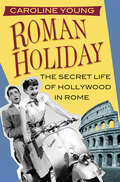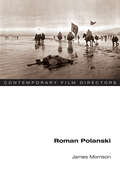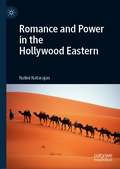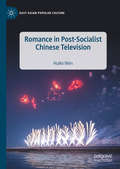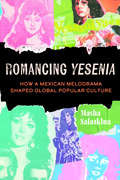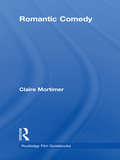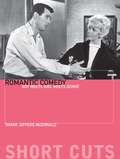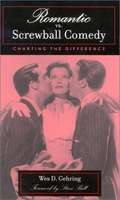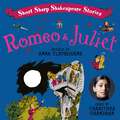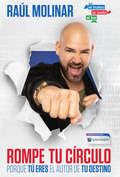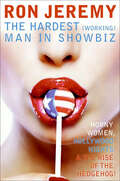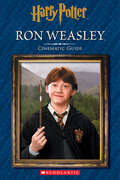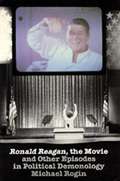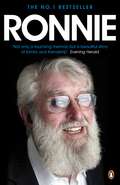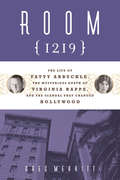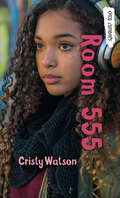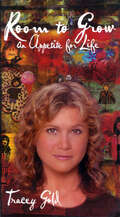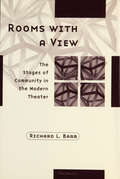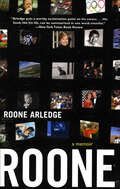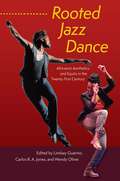- Table View
- List View
Roman Holiday: The Secret Life of Hollywood in Rome
by Caroline YoungRome in the 1950s: following the darkness of fascism and Nazi occupation during the Second World War, the city is reinvigorated. The street cafés and nightclubs are filled with movie stars and film directors as Hollywood productions flock to the city to film at Cinecittà Studios. Fiats and Vespas throng the streets, and the newly christened paparazzi mingle with tourists enjoying la dolce vita. It is a time of beauty, glamour – and more than a little scandal. Caroline Young explores the city in its golden age, as the emergence of celebrity journalism gave rise to a new kind of megastar. They are the ultimate film icons: Ava Gardner, Anna Magnani, Sophia Loren, Audrey Hepburn, Ingrid Bergman and Elizabeth Taylor. Set against the backdrop of the stunning Italian capital, the story follows their lives and loves on and off the camera, and the great, now legendary, films that marked their journeys. From the dark days of the Second World War through to the hedonistic hippies in the late 1960s, this evocative narrative captures the essence of Rome – its beauty, its tragedy and its creativity – through the lives of those who helped to recreate it.
Roman Polanski (Contemporary Film Directors)
by James MorrisonA new take on an eclectic and controversial director James Morrison's critical study offers a comprehensive and critically engaged treatment on Roman Polanski's immense body of work. Tracing the filmmaker's remarkably diverse career from its beginnings to 2007, the book provides commentary on all of Polanski's major films in their historical, cultural, social, and artistic contexts. Morrison locates Polanski's work within the genres of comedy and melodrama, arguing that he is not merely obsessed with the theme of repression, but that his true interest is in the concrete—what is out in the open—and why we so rarely see it. The range of Polanski's filmmaking challenges traditional divisions between high and low culture. For example, The Ninth Gate is a brash pastiche of the horror genre, while The Pianist is an Academy Award-winner about the Holocaust. Dubbing Polanski a relentless critic of modernity, Morrison concludes that his career is representative of the fissures, victories, and rehabilitations of the last fifty years of international cinema. A volume in the series Contemporary Film Directors, edited by James Naremore
Romance
by David MametExhilarating courtroom farce from America's finest playwright. Romance is an uproarious courtroom farce which lampoons the American judicial system and exposes the hypocrisy surrounding personal prejudices and political correctness. Wildly humorous and often gob-smackingly outrageous, the play is set in a modern-day courtroom in New York during a week when there are Middle East peace talks being brokered in town. The court case at hand is unrelated, but the defendant and counsel come up with a plan to solve the conflict in the region. A pill-popping judge, a defendant and lawyer (on the same side) who hate each other, and a prosecutor with a troubled personal life are part of the picture. A new comedy from 'the finest American playwright of his generation' Sunday Times. 'A deliriously funny David Mamet farce' Associated Press. 'An exhilarating spectacle. Mamet is a connoisseur of fiasco, knows all about legal punctilio, and he has great fun bringing mayhem to the ritual' New Yorker. Published to tie-in with the play's European premiere at the Almeida Theatre, opening 6th September 2005.
Romance and Power in the Hollywood Eastern
by Nalini NatarajanThis book develops the existence of the "Eastern" as an analytically significant genre of film. Positioned in counterpoint to the Western, the famed cowboy genre of the American frontier, the “Eastern” encompasses films that depict the eastern and southern frontiers of Euro-American expansion. Examining six films in particular—Gunga Din (1939), Lawrence of Arabia (1962), Heat and Dust (1983), A Passage to India (1984), Indochine (1992), and The English Patient (1996)—the author explores the duality of the "Eastern" as both aggressive and seductive, depicting conquest and romance at the same time. In juxtaposing these two elements, the book seeks to reveal the double process by which the “Eastern” both diminishes the "East" and Global South and reinforces ignorance about these regions’ histories and complexity, thereby setting the stage for ever-escalating political aggression.
Romance in Post-Socialist Chinese Television (East Asian Popular Culture)
by Huike WenThis book is about how the representations of romantic love in television reflect the change and the dilemma of the dominant values in post-socialist Chinese mainstream culture. These values mainly center on the impact of individualism, consumerism, capitalism, and neoliberalism, often referred to as western culture, on the perception of romantic love and self-realization in China.The book focuses on how romantic love, which plays a vital role in China’s ideologically highly restricted social environment by empowering people with individual choice, change, and social mobility, must struggle and compromise with the reality, specifically the values and problems emerging in a transitional China. The book also examines how the representation of romantic love celebrates ideals—individual freedom, passion, and gender equality—and promises changes based on individual diligence and talent while simultaneously obstructing the fulfillment of these ideals.
Romances de escritores
by Daniel Balmaceda¿Quiénes se enamoraron de la misma mujer? ¿Qué escritores se pelearon por el amor de Alfonsina? ¿Quién conoció a su amante en casa de Sabato? El autor del exitoso Romances turbulentos de la historia argentina nos sumerge, una vez más, en el sentimiento más poderoso del mundo: el amor. Como dice Daniel Balmaceda, las historias de Romances de escritores nos trasladan directo al corazón de aquellos escritores del siglo XX que supieron canalizar sus sentimientos para darles vida en su obra. Lugones, Borges, Victoria y Silvina Ocampo, Alfonsina Storni, Macedonio Fernández, Arlt, Bioy Casares, Girondo, Mujica Lainez y Silvina Bullrich son algunos de los protagonistas de este libro. Pero a estos romances argentinos también se suman extranjeros cuyas aventuras o desventuras amorosas se relacionaron con nuestro país, como ocurrió con Horacio Quiroga, García Lorca, Saint-Exupéry, Neruda y Octavio Paz. Las historias de amor se entrecruzan en un gran laberinto de enredos geniales.
Romancing Yesenia: How a Mexican Melodrama Shaped Global Popular Culture
by Masha SalazkinaOne of the Best Scholarly Books of 2023, The Chronicle of Higher EducationA free ebook version of this title is available through Luminos, University of California Press's Open Access publishing program. Visit www.luminosoa.org to learn more. This book follows the production, transnational circulation, and reception of the highest grossing film in the history of Soviet exhibition, the 1971 Mexican romance Yesenia. The film adaptation of a telenovela based on a wildly popular graphic novel set during the Second Franco-Mexican War became a surprise hit in the USSR, selling more than ninety million tickets in the first year of its Soviet release alone. Drawing on years of archival research, renowned film scholar Masha Salazkina takes Yesenia’s unprecedented popularity as an entry point into a wide-ranging exploration of the cultures of Mexico and the Soviet Union in the 1970s and of the ways in which popular culture circulated globally. Paying particular attention to the shifting landscape of sexual politics, Romancing "Yesenia" argues for the enduring importance and ideological ambiguities of melodramatic forms in global popular media.
Romantic Comedy (Routledge Film Guidebooks)
by Claire MortimerRomantic comedy is an enduringly popular genre which has maintained its appeal by constantly evolving, from the screwball comedy to the recent emergence of the bromance. Romantic Comedy examines the history of the genre, considering the social and cultural context for key developments in new genre cycles. It studies the key themes and issues at work within romantic comedy films, focusing in particular on the representation of gender and how the genre acts as a barometer for gender politics in the course of the twentieth century. Claire Mortimer provides the reader with a comprehensive overview of the genre, tracing its development, enduring appeal, stars and the nature of its comedy. Mortimer discusses both British and Hollywood classic and contemporary romantic comedies, ranging from canonical films to more recent examples which have taken the genre in new directions. In-depth case studies span a wide variety of films, including: It Happened One Night Bringing Up Baby Annie Hall Four Weddings and a Funeral Bridget Jones’s Diary Wimbledon Knocked Up Sex and the City This book is the perfect introduction to the romantic comedy genre and will be particularly useful for all those investigating this area within film, media or women's studies.
Romantic Comedy: Boy Meets Girl Meets Genre
by Mcdonald Tamar JeffersRomantic Comedy offers an introduction to the analysis of a popular but overlooked film genre. The book provides an overview of Hollywood's romantic comedy conventions, examining iconography, narrative patterns, and ideology. Chapters discuss important subgroupings within the genre: screwball sex comedy and the radical romantic comedy of the 1970s. A final chapter traces the lasting influence of these earlier forms within current romantic comedies. Films include: Pillow Talk (1959), Annie Hall (1977), and You've Got Mail (1998).
Romantic Comedy: Boy Meets Girl Meets Genre (Short Cuts)
by Tamar Jeffers McDonaldRomantic Comedy offers an introduction to the analysis of a popular but overlooked film genre. The book provides an overview of Hollywood's romantic comedy conventions, examining iconography, narrative patterns, and ideology. Chapters discuss important subgroupings within the genre: screwball sex comedy and the radical romantic comedy of the 1970s. A final chapter traces the lasting influence of these earlier forms within current romantic comedies. Films include: Pillow Talk (1959), Annie Hall (1977), and You've Got Mail (1998).
Romantic vs. Screwball Comedy: Charting the Difference
by Wes D. JehringThis examination of film comedies distinguishes the elements which separate the screwball comedy from the romantic comedy. A great resource for film scholars, movie fans, and writers.
Romeo and Juliet (Short, Sharp Shakespeare Stories #27)
by Anna ClaybourneO Romeo, Romeo! Wherefore art thou Romeo?Two families at war, and a pair of young, star-crossed lovers caught in the crossfire... Listen on, through romance and heartbreak, to discover the tragic story at the heart of Romeo and Juliet, one of Shakespeare's most famous plays.As well as the story, this audiobook contains information about the background to Romeo and Juliet, its major themes, language, and Shakespeare's life during the time he was writing the play. Poisons, and their application in 16th century England, are also examined, to give the context in which the play was written.The Short, Sharp Shakespeare series consists of six books that retell Shakespeare's most famous plays in modern English. Fun sound effects and atmospheric music accompany each narration, making them a great introduction to "the Bard" for children.(P) 2023 Hodder & Stoughton Limited
Rompe tu círculo: Por que tú eres el autor de tu destino
by Raúl Molinar Univision Interactive MediaA través de las ondas radiales Raúl Molinar #El Bueno#, del popular show matutino #El Bueno La Mala y El Feo# ha podido formar parte de la vida de sus oyentes. #Cada día me levanto con el ánimo y la disposición de colaborar de alguna forma para que esta vida sea un poquito más llevadera. Pero sentía que faltaba algo, que todavía podía hacer más# Y ése es el objetivo de este libro#. A través de las páginas de Rompe tu círculo el lector descubrirá anécdotas de la vida de #El Bueno#, así como algunos de los métodos que ha utilizado para alcanzar su objetivo, desde la pareja ideal, hasta la estabilidad económica. El autor revela cómo, gracias a una aventura prohibida, encontró al amor de su vida. Habla sin tapujos de los malabares que tuvo que hacer antes de convertirse en locutor# y de seguir adelante con su sueño. #Seguramente te vas a identificar con algunas historias, te reirás con otras y en ciertos casos, puede que te sorprendas descubriendo mis flaquezas. Pues soy como tú, con mis luces y mis sombras#, confiesa. Raúl ha vivido momentos de gloria y otros que han sido un verdadero calvario. Ha tenido aciertos y ha cometido muchos errores. Pero la gran lección que comparte es que siempre hay luz al final del túnel. Siempre hay una nueva oportunidad para romper esos círculos que nos hacen daño, que envenenan el alma y nos impiden ser feliz. En Rompe tu círculo Raúl te invita a que cambies las excusas y tragedias del pasado por la esperanza en el futuro. #Espero que estas líneas te sirvan de compañía para esas noches más oscuras y esos días grises. Te den la motivación para ir por tus sueños, por más locos que parezcan #dice el autor#. Espero que este libro te sirva de inspiración al darte cuenta de que, si un morrito de Chihuahua pudo hacerla, ¡pos, tú también puedes! La llave maestra del éxito la tienes en tus manos. Acuérdate que a cada puerco le llega su Navidad#.
Ron Jeremy: The Hardest (Working) Man in Showbiz
by Ron JeremyHe's the porn world's Everyman. Blessed with an enormous "talent" yet average looks, he's starred in more than 1,700 adult films, directed 250 of them, and over the last twenty years has become porn's biggest ambassador to the mainstream. He's appeared in 60 regular films, 14 music videos, and VH1's Surreal Life, starred in the critically acclaimed Porn star (a movie about his life), and in Being Ron Jeremy (a take off on Being John Malkovich), co-starring Andy Dick. And that's just the tip of the iceberg. . . . Ron Jeremy is a born storyteller (funny, considering he doesn't do a lot of talking in his films). He knows where all the bodies are buried, and in this outrageous autobiography he not only shows you the grave but also gives you the back story on the tombstone. Get ready for Ron Jeremy—a scandalously entertaining deep insider's view of the porn industry and its emergence into popular culture, and a delectable self-portrait of the amazingly endowed Everyman every man wanted to be.
Ron Weasley: Cinematic Guide (Harry Potter)
by Felicity BakerThe Essential Film Companion for RON WEASLEY that's perfect for the youngest fans! Relive the magical moments when Ron Weasley proved just as courageous and loyal as his famous best friend, Harry Potter; whether he was facing the Slytherin Quidditch team or a forest of scary giant spiders! This collection of photographs and quotes from all eight HARRY POTTER films takes a closer look at Ron's life, including his time at Hogwarts, family and friends, and dangerous battles against the Dark Lord, Voldemort.The experience of this eBook will be best if viewed on a tablet.
Ronald Reagan the Movie, and Other Episodes in Political Demonology
by Michael Paul RoginThe fear of the subversive has governed American politics, from the racial conflicts of the early republic to the Hollywood anti-Communism of Ronald Reagan. Political monsters- the Indian cannibal, the black rapist, the many-tentacled Communist conspiracy, and the agents of international terrorism- are familiar figures in the dream life that so often dominates American political consciousness.
Ronnie
by Ronnie DrewThe late great Dubliner, Ronnie Drew, was six months into writing his biography when he was diagnosed with cancer. He had produced warm, witty and insightful material that made it clear that he was a wonderful writer as well as a great singer and storyteller. With the encouragement of his wife Deirdre and his family, he continued to think about the book and conducted a number of interviews to keep things ticking over until he was well enough to resume work on it. But sadly, much as he wanted to, Ronnie did not get to finish his story.However, with the whole-hearted co-operation of his daughter and son, Cliodhna and Phelim, it has been possible to put together Ronnie's work on his memoir along with his other writings, interviews with Cliodhna and Phelim, a wealth of photographs and other material from the family archive, and contributions from close friends, to create a book that is a wonderful portrait of, and a fitting and loving tribute to, the man Bono called 'the king of Ireland'.
Room 1219: The Life of Fatty Arbuckle, the Mysterious Death of Virginia Rappe, and the Scandal That Changed Hol
by Greg MerrittPart biography, part true-crime narrative, this painstakingly researched book chronicles the improbable rise and stunning fall of Roscoe "Fatty" Arbuckle from his early big screen success to his involvement in actress Virginia Rappe's death, and the resulting irreparable damage to his career. It describes how during the course of a rowdy party hosted by the comedian in a San Francisco hotel, Rappe became fatally ill, and Arbuckle was subsequently charged with manslaughter. Ultimately acquitted after three trials, neither his career nor his reputation ever recovered from this devastating incident. Relying on a careful examination of documents, the book finally reveals what most likely occurred that Labor Day weekend in 1921 in that fateful hotel room. In addition, it covers the evolution of the film industry--from the first silent experiments to the connection between Arbuckle's scandal and the implementation of industry-wide censorship that altered the course of Hollywood filmmaking for five decades.
Room 555 (Orca Currents)
by Cristy WatsonFourteen-year-old Roonie loves hip-hop almost as much as she loves her grandmother. Roonie cannot wait to compete in her school's dance competition. But as her grandmother's health deteriorates, Roonie becomes more and more reluctant to visit her in the care home. These feelings of guilt and frustration cause Roonie to mess things up with her hip-hop dance partner and best friend, Kira. But while doing some volunteer hours in the hospital geriatric ward, Roonie meets an active senior recovering from a bad fall. Their shared love of dance and the woman's zest for life help Roonie face her fears, make amends with Kira and reconnect with Gram before it’s too late. This short novel is a high-interest, low-reading level book for middle-grade readers who are building reading skills, want a quick read or say they don’t like to read!
Room to Dream: A Life In Art
by David Lynch Kristine McKennaAn unprecedented look into the personal and creative life of the visionary auteur David Lynch, through his own words and those of his closest colleagues, friends, and family In this unique hybrid of biography and memoir, David Lynch opens up for the first time about a life lived in pursuit of his singular vision, and the many heartaches and struggles he’s faced to bring his unorthodox projects to fruition. Lynch’s lyrical, intimate, and unfiltered personal reflections riff off biographical sections written by close collaborator Kristine McKenna and based on more than one hundred new interviews with surprisingly candid ex-wives, family members, actors, agents, musicians, and colleagues in various fields who all have their own takes on what happened. Room to Dream is a landmark book that offers a onetime all-access pass into the life and mind of one of our most enigmatic and utterly original living artists. With insights into . . . Eraserhead The Elephant Man Dune Blue Velvet Wild at Heart Twin Peaks Twin Peaks: Fire Walk with Me Lost Highway The Straight Story Mulholland Drive INLAND EMPIRE Twin Peaks: The Return
Room to Grow: An Appetite for Life
by Julie McCarron Tracey GoldTracey Gold was well known to television audiences in the 1980s and ‘ 90s as the wholesome teenage sister on the long-running series Growing Pains. She co-starred for eight years alongside Kirk Cameron as brainy sister Carol Seaver in a picture-perfect American family. A working actress since the age of 4, she was a pretty and professional young star with a limitless future. But behind the smiles, Tracey was fighting the battle of her life. Photos of the shockingly thin Tracey faced readers from the cover of People magazine, revealing her struggle with an eating disorder that had plagued her for years. In this candid memoir, the actress recounts her offscreen troubles that viewers were unaware of at the time. Room to Grow is a moving account of a trip to hell and back. It is a journey of self-discovery and a chronicle of the very difficult lessons Tracey learned about coping in a society where emaciation is the ultimate ideal.
Rooms with a View: The Stages of Community in the Modern Theater (Theater: Theory/Text/Performance)
by Richard Lewis BarrIn Sam Shepard's play Action a character asks, "What's a community?" only to find that no one really knows. Rooms with a View attempts to chart the development of communal concepts through the discourse of dramatic modernism, defining a coherent pattern that illustrates and anticipates innovations in modern and postmodern social theory. To clarify the commonplace notion that audiences actively participate in dramatic art, the intro-ductory chapter theorizes a performance community, which audience, actors, and other backstage actants (such as playwrights and directors) provisionally form in the theater. Connecting psychological, sociological, and aesthetic insights ranging from Freud to Kohut, from Simmel to Nancy, and from Artaud and Brecht to Arnheim and Jellicoe, Richard Barr shows how modernist thinkers are repeatedly drawn to the ideal of communion. The distinctive structure of this collective inquiry helps untangle the roots and routes of modern drama and social thought. Barr analyzes the social and aesthetic theory of four in-fluential dramatists. Ibsen and Strindberg, he claims, explore ways of acknowledging the integrity of individual viewpoints while maintaining collective coherence. Pirandello and, in more radical ways, Beckett, conclude that conflict and division are not simply inevitable but invaluable in organizing alternative perspectives. By analyzing the ways playwrights variously conceive and achieve the complicated unity called community, Rooms with a View produces the rich paradox that difference may make the most difference in creative communal consensus. Richard L. Barr holds a Ph.D. from the University of Virginia, and has taught English at Rutgers University. He is currently a specialist in intersubjective relations, practicing in New Jersey and Switzerland.
Roone: A Memoir
by Roone ArledgeRoone Arledge's extraordinary career of more than a half century mirrors the history of the television industry he helped create. Roone is the vivid, intimate account of his own rise to fame and power as the head of both ABC Sports and ABC News as well as an up-close-and- personal story of his era, peopled with friends and foes alike.
Rooted Jazz Dance: Africanist Aesthetics and Equity in the Twenty-First Century
by Wendy Oliver Lindsay Guarino Carlos R. A. JonesNational Dance Education Organization Ruth Lovell Murray Book AwardUNCG | Susan W. Stinson Book Award for Dance EducationStrategies for recovering the Africanist roots of jazz dance in teaching and practice An African American art form, jazz dance has an inaccurate historical narrative that often sets Euro-American aesthetics and values at the inception of the jazz dance genealogy. The roots were systemically erased and remain widely marginalized and untaught, and the devaluation of its Africanist origins and lineage has largely gone unchallenged. Decolonizing contemporary jazz dance practice, this book examines the state of jazz dance theory, pedagogy, and choreography in the twenty-first century, recovering and affirming the lifeblood of jazz in Africanist aesthetics and Black American culture.Rooted Jazz Dance brings together jazz dance scholars, practitioners, choreographers, and educators from across the United States and Canada with the goal of changing the course of practice in future generations. Contributors delve into the Africanist elements within jazz dance and discuss the role of Whiteness, including Eurocentric technique and ideology, in marginalizing African American vernacular dance, which has resulted in the prominence of Eurocentric jazz styles and the systemic erosion of the roots. These chapters offer strategies for teaching rooted jazz dance, examples for changing dance curricula, and artist perspectives on choreographing and performing jazz. Above all, they emphasize the importance of centering Africanist and African American principles, aesthetics, and values.Arguing that the history of jazz dance is closely tied to the history of racism in the United States, these essays challenge a century of misappropriation and lean into difficult conversations of reparations for jazz dance. This volume overcomes a major roadblock to racial justice in the dance field by amplifying the people and culture responsible for the jazz language.Contributors: LaTasha Barnes | Lindsay Guarino | Natasha Powell | Carlos R.A. Jones | Rubim de Toledo | Kim Fuller | Wendy Oliver | Joanne Baker | Karen Clemente | Vicki Adams Willis | Julie Kerr-Berry | Pat Taylor | Cory Bowles | Melanie George | Paula J Peters | Patricia Cohen | Brandi Coleman | Kimberley Cooper | Monique Marie Haley | Jamie Freeman Cormack | Adrienne Hawkins | Karen Hubbard | Lynnette Young Overby | Jessie Metcalf McCullough | E. Moncell DurdenPublication of this work made possible by a Sustaining the Humanities through the American Rescue Plan grant from the National Endowment for the Humanities.
Roots of the New Arab Film
by Roy ArmesRoots of the New Arab Film deals with the generation of filmmakers from across North Africa and the Middle East who created an international awareness of Arab film from the mid-1980s onwards. These seminal filmmakers experienced the moment of national independence first-hand in their youth and retained a deep attachment to their homeland. Although these aspiring filmmakers had to seek their training abroad, they witnessed a time of filmic revival in Europe – Fellini and Antonioni in Italy, the French New Wave, and British Free Cinema.Returning home, these filmmakers brought a unique insider/outsider perspective to bear on local developments in society since independence, including the divide between urban and rural communities, the continuing power of traditional values and the status of women in a changing society. As they made their first films back home, the feelings of participation in a worldwide movement of new, independent filmmaking was palpable. Roots of the New Arab Film is a necessary and comprehensive resource for anyone interested in the foundations of Arab cinema.
